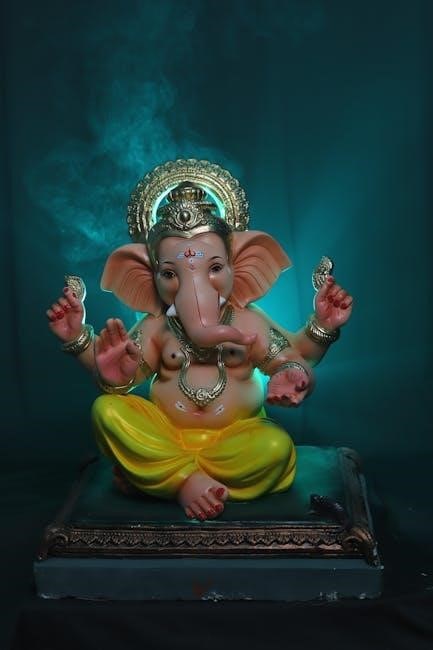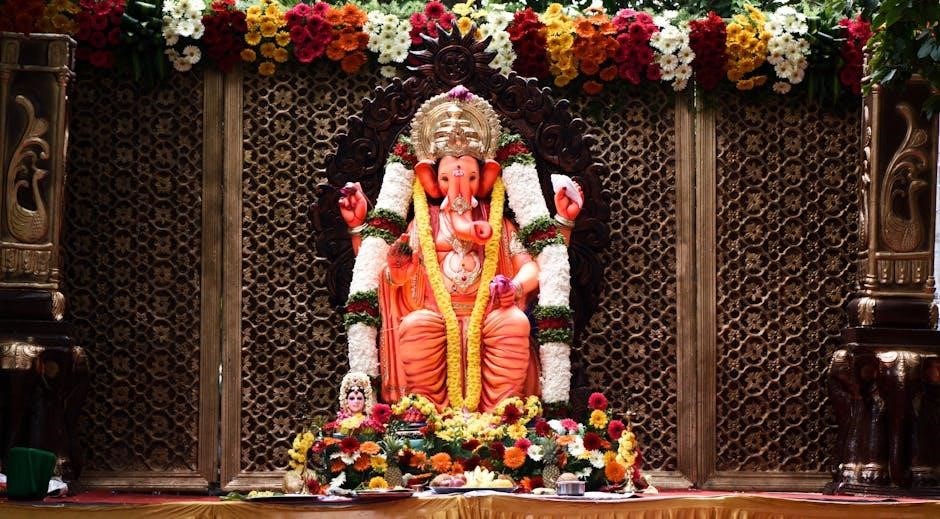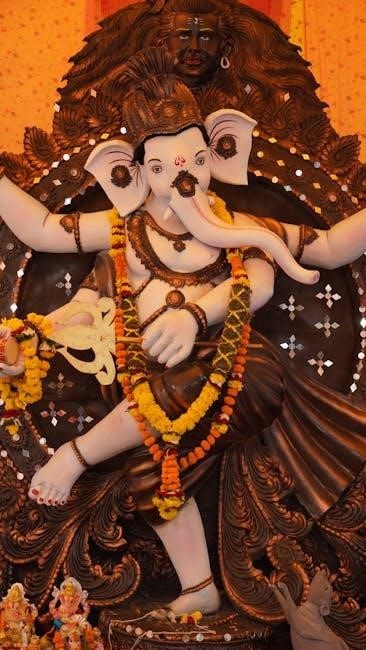William Golding’s “Lord of the Flies” is a gripping tale of survival and human nature, available in PDF, EPUB, and TXT formats for convenient reading.
Overview of the Novel
William Golding’s Lord of the Flies, published in 1954, explores the descent into chaos of a group of boys stranded on a tropical island after a plane crash. The novel examines themes of human nature, civilization, and savagery, offering a haunting portrayal of how quickly societal norms can unravel. Its availability in PDF format ensures easy access to this timeless exploration of humanity’s darker instincts.
Significance of the PDF Format
The PDF format of Lord of the Flies enhances readability and accessibility, allowing readers to engage with William Golding’s timeless themes seamlessly across devices. This digital version preserves the original text’s integrity while offering convenient features like search and zoom, making it ideal for both casual readers and academic study. Its availability in PDF ensures the novel remains accessible to a global audience.

Plot Summary
A group of boys, stranded on an island after a plane crash, struggle with leadership, survival, and morality, descending into chaos and savagery.
Setting and Initial Crash
The story unfolds on a tropical island during an unspecified nuclear war in Europe. A group of British boys, evacuated to Australia, crash-land on the island after their plane is shot down. The crash occurs in a dense part of the island, creating a “scar,” and results in no adult survivors. The boys find themselves stranded, surrounded by dense forests and a lagoon, setting the stage for their struggle to survive and govern themselves.
Development of the Story
The boys establish a fragile democracy, electing Ralph as leader. They focus on building shelters and maintaining a signal fire. However, fear of the “beast” and power struggles emerge, leading Jack to form his own tribe. As tensions rise, the group’s civility erodes, replaced by primal instincts and savagery, highlighting the clash between order and chaos in their isolated world.
Climax and Resolution
The climax unfolds as Jack’s tribe hunts Ralph, setting the island ablaze. Ralph flees, seeking refuge near the shore, where a naval officer rescues him. The officer’s arrival restores order, revealing the boys’ descent into savagery. Ralph reflects on the darkness within humanity, symbolizing the loss of innocence. The novel concludes with Ralph weeping for the end of childhood and the realization of human nature’s duality.
Themes in “Lord of the Flies”
Golding explores human nature, civilization, and fear, revealing how isolation unravels morality. The PDF highlights themes of power, savagery, and the loss of innocence through the boys’ actions.
Human Nature and Civilization
Golding explores the duality of human nature, revealing how civilization’s veneer is thin. The PDF highlights the boys’ descent into chaos, illustrating primal instincts and savagery as societal norms fade.
Power and Leadership
The PDF version of “Lord of the Flies” delves into power dynamics, contrasting Ralph’s democratic ideals with Jack’s authoritarian rule. Leadership struggles mirror human societies, showing how ambition and fear can corrupt even the noblest intentions, as the boys’ island society fractured under conflicting desires for control.
Fear and the Supernatural
The PDF of “Lord of the Flies” explores how fear of the supernatural, symbolized by the “beast,” grips the boys, reflecting their primal anxieties. This fear escalates tensions, driving the group toward chaos and savagery. Golding uses the beast as a metaphor for the inherent evil within humans, showcasing how unchecked fear dismantles rationality and civility, plunging the island into darkness.

Character Analysis
The PDF of “Lord of the Flies” delves into the characters’ psychological growth, with Ralph embodying order, Jack symbolizing power, and Piggy representing intellect and morality.
Ralph and His Leadership
Ralph, the protagonist, embodies democracy and order, initially uniting the boys with his conch shell. His leadership focuses on shelter and rescue, reflecting civilized ideals. However, as chaos rises, Ralph’s authority wanes, highlighting his internal struggle between morality and primal instincts. The PDF version captures his symbolic role, illustrating how his leadership represents the fragile balance between humanity and savagery, ultimately revealing the depths of human nature’s duality.
Jack Merridew’s Transformation
Jack’s transformation from a choirboy to a power-hungry leader is central to the novel. Initially, he seeks acceptance but gradually embraces savagery, obsessed with hunting and control. The PDF highlights his descent into darkness, symbolizing the collapse of civilization. His painted face and tribal behavior mark a shift from innocence to ruthlessness, mirroring the inherent human tendency toward primal instincts when societal structures crumble and true nature prevails.
Piggy’s Role and Symbolism
Piggy, the intelligent and rational voice, represents logic and civilization. His glasses symbolize clarity and wisdom, while his asthma underscores his physical vulnerability. The PDF version emphasizes his role as a moral compass, advocating for order and democracy. Piggy’s eventual death signifies the destruction of reason and the triumph of savagery, highlighting the novel’s exploration of humanity’s duality and the fragility of civilized norms in the absence of societal constraints.

Symbols in the Novel
The conch shell, beast, and island are central symbols in “Lord of the Flies,” representing order, fear, and isolation. The PDF highlights these elements vividly.
The Conch Shell
The conch shell symbolizes order and democracy in “Lord of the Flies.” Found by Ralph, it is used to summon meetings and ensure speaking turns, representing civilized structure. Its power fades as chaos grows, reflecting the boys’ decline into savagery. The PDF version highlights this symbol’s significance, emphasizing its role in maintaining unity and the inevitable loss of moral authority as the story unfolds.
The Beast
The Beast is a mysterious entity feared by the boys, embodying their primal anxieties. It becomes a central fear, driving their actions and divisions. The PDF version of “Lord of the Flies” explores how the Beast symbolizes the inherent evil within humans, as the boys’ paranoia grows, leading to violence and the breakdown of their civilized behavior, revealing the true nature of humanity’s darker instincts.
The Island Itself
The island serves as both a sanctuary and a prison, symbolizing isolation and the absence of adult supervision. Its beauty contrasts with the boys’ descent into savagery. The PDF format of “Lord of the Flies” highlights the island’s dual role as a setting where innocence fades and primal instincts emerge, shaping the boys’ actions and the novel’s themes of civilization versus barbarism in a confined, natural environment.

William Golding: The Author
William Golding (1911–1993) was a British novelist, playwright, and poet, best known for “Lord of the Flies.” He won the Nobel Prize in Literature in 1983 for his works exploring human nature and society.
Golding’s Background
William Golding was born on September 19, 1911, in St. Columb Minor, Cornwall, England. He studied natural sciences at Oxford University but later shifted to literature. Before WWII, he worked as a teacher and actor. His experiences during the war profoundly influenced his writing. Golding’s literary career began after the war, leading to the publication of “Lord of the Flies” in 1954. His works explore human nature, earning him the Nobel Prize in Literature in 1983.
His Writing Style
William Golding’s writing style is characterized by vivid symbolism, moral allegory, and a concise yet powerful prose. His narratives often explore the complexities of human nature, blending philosophical themes with gripping storytelling. Golding’s ability to create immersive settings and deeply symbolic elements, such as the conch shell and the beast, underscores his mastery of literary craftsmanship. His work remains timeless, resonating with readers across generations.
Other Notable Works
Beyond “Lord of the Flies,” William Golding authored several impactful novels, including “The Inheritors,” which explores the decline of the Neanderthals, and “Pincher Martin,” a psychological journey of survival. His works often delve into human nature, morality, and existential themes, showcasing his versatility and depth as a writer. These books, like his debut, continue to captivate readers and scholars alike, solidifying his literary legacy.

PDF and E-Book Availability
“Lord of the Flies” is widely available in PDF, EPUB, and TXT formats, offering readers convenient access to this timeless classic. Digital versions ensure easy readability.
Downloading the PDF
Downloading the PDF of “Lord of the Flies” is straightforward. The novel is widely available online in various formats, including PDF, ensuring easy access. Readers can find free downloads on reputable sites or purchase it from digital bookstores. The PDF version offers a convenient reading experience, compatible with multiple devices, making it ideal for both casual readers and academic purposes. A quick search on platforms like Google or online libraries will provide direct links to the file.
Popularity of the E-Book
The e-book version of “Lord of the Flies” remains highly popular, with the PDF format being a favorite among readers. Its portability and accessibility make it ideal for modern readers. The novel’s timeless themes and thought-provoking narrative continue to attract readers worldwide. The e-book’s popularity is further boosted by its availability on major platforms, ensuring it reaches a broad audience. Its digital form has made it a staple in both educational and casual reading settings.
Benefits of Reading Digitally
Reading “Lord of the Flies” in digital formats like PDF offers numerous advantages. It allows for easy access across devices, adjustable fonts for readability, and quick navigation through chapters. Digital copies are space-saving, environmentally friendly, and often more affordable. Features like search functions and annotations enhance the reading experience, making it ideal for both casual readers and students conducting close analyses of the text.

Theological and Literary References
“Lord of the Flies” explores religious symbolism, with the island mirroring Eden and the beast embodying evil, while its themes reflect philosophical questions about human nature.
Religious Symbolism
William Golding’s Lord of the Flies is rich in religious symbolism, with the island representing a fallen Eden. The beast embodies evil, mirroring biblical notions of sin, while the conch shell symbolizes order and divine authority. The boys’ struggle reflects the battle between good and evil, resonating with theological themes of humanity’s inherent flaws and the need for moral guidance. The novel’s exploration of these themes adds depth to its universal appeal.
Philosophical Undertones
Lord of the Flies explores deep philosophical questions about human nature, morality, and society. Golding’s portrayal of the boys’ descent into chaos reflects Thomas Hobbes’ view of humanity as inherently self-interested. The novel critiques the idea of innate innocence, suggesting that civilization is a fragile construct. It also examines the tension between individual desire and collective order, raising profound questions about the origins of moral behavior and the effects of isolation on human ethics.

Educational Use
The PDF version of Lord of the Flies is widely used in schools for its themes of human nature, morality, and civilization, supported by study guides and resources.
Curriculum Inclusion
The PDF version of Lord of the Flies is often included in high school and college curricula due to its exploration of human nature, morality, and societal structures. Its themes align with literature courses focusing on classical texts and contemporary issues. The novel’s availability in digital formats makes it easily accessible for students and educators, enhancing its educational value globally.
Study Guides and Resources
Study guides for Lord of the Flies are widely available online, offering analysis of themes, characters, and literary devices. PDF versions provide concise summaries and critical essays, aiding students in understanding the novel’s depth. These resources are invaluable for classroom discussions and individual study, complementing the digital version of the book for a comprehensive learning experience.

Reception and Legacy
William Golding’s Lord of the Flies has received widespread critical acclaim for its profound exploration of human nature and civilization. Its themes resonate universally, making it a timeless classic in literature. The PDF version enhances accessibility, ensuring its legacy endures across generations of readers.
Critical Acclaim
Lord of the Flies has garnered widespread critical acclaim for its profound exploration of human nature, morality, and civilization. William Golding’s haunting prose and vivid imagery captivate readers, earning the novel a permanent place in literary history. Its themes of inherent evil and societal breakdown resonate deeply, solidifying its status as a modern classic. The PDF version ensures accessibility, allowing readers worldwide to engage with Golding’s timeless insights.
Cultural Impact
Lord of the Flies has left an indelible mark on popular culture, influencing literature, film, and society. Its exploration of human savagery and civilization’s fragility continues to spark debates. The novel’s themes are timeless, resonating across generations. The availability of the PDF version has further amplified its reach, making it accessible to global readers and ensuring its relevance in modern discourse on human nature and societal structures.

Why Read “Lord of the Flies”
Exploring themes of humanity and civilization, “Lord of the Flies” offers a profound insight into societal structures, making it a must-read for understanding human behavior and ethics.
Timeless Themes
The novel explores universal themes of human nature, civilization, and savagery, resonating across generations. Its examination of power, fear, and morality remains relevant today, offering insights into societal structures and individual behavior. The struggle between order and chaos, as well as the psychological effects of isolation, continues to captivate readers. These enduring themes ensure the book’s lasting impact, making its PDF format a convenient way to engage with its profound ideas and reflections on humanity.
Literary Significance
“Lord of the Flies” is a seminal work in 20th-century literature, earning William Golding the Nobel Prize in Literature. Its exploration of human nature, society, and morality has made it a classic. The novel’s ability to provoke thought on civilization’s fragility and inherent human tendencies solidifies its literary importance. Accessing it in PDF format ensures its timeless themes remain accessible to modern readers, fostering engagement with its profound insights into human behavior and societal structures.
The PDF version of “Lord of the Flies” offers a convenient way to explore its timeless themes, making it easily accessible for modern readers worldwide.
Final Thoughts
William Golding’s “Lord of the Flies” remains a powerful exploration of humanity, with its PDF format ensuring accessibility. The novel’s themes of civilization and savagery resonate deeply, making it a timeless classic. The convenience of digital versions allows readers to engage with Golding’s profound insights effortlessly, ensuring the story’s relevance across generations. Its availability in various formats underscores its enduring appeal and intellectual impact.
Encouragement to Read
Engaging with “Lord of the Flies” through its PDF format offers a seamless reading experience. William Golding’s masterpiece explores timeless themes of human nature, making it essential for both academic and personal enrichment. The convenience of digital access ensures that readers can delve into its profound insights anywhere, fostering a deeper understanding of civilization’s fragility and humanity’s complexities.
